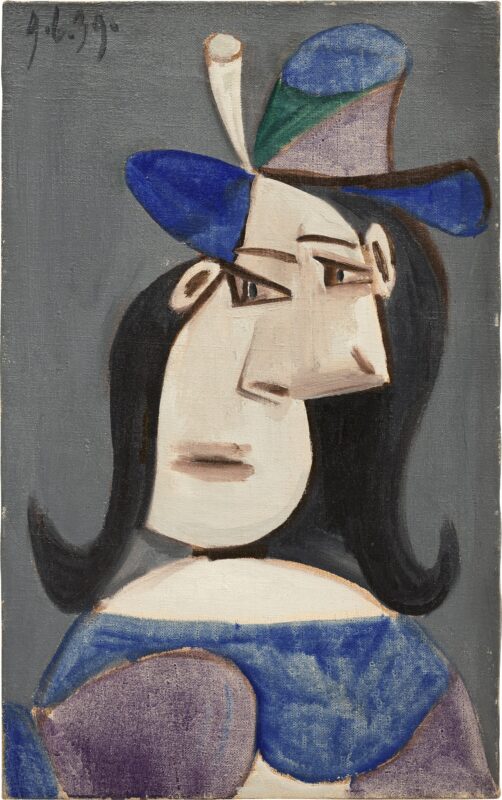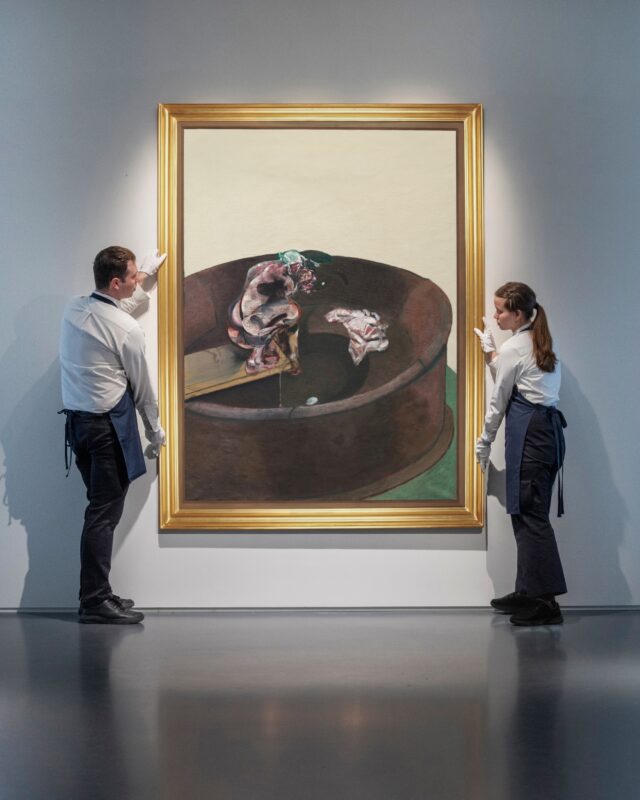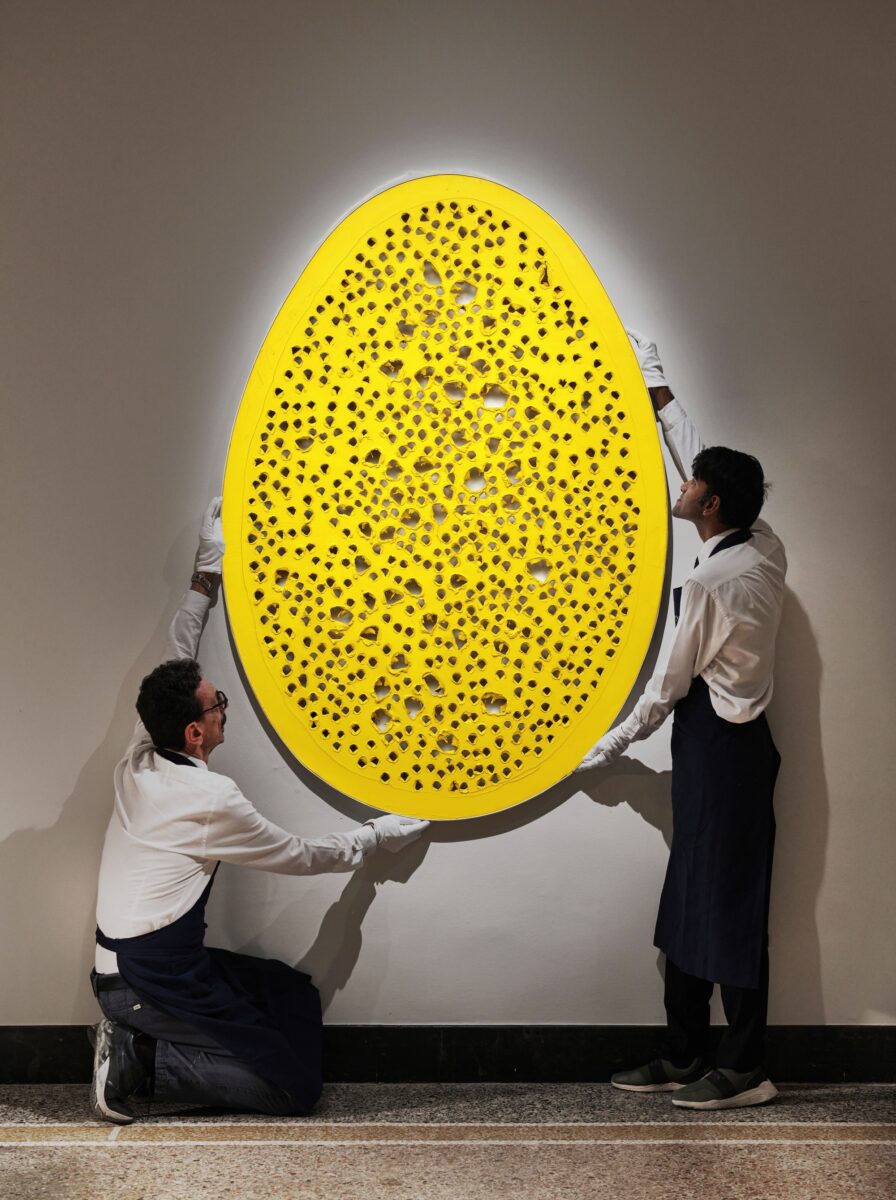
[La fine di Dio] for me means the infinity, the inconceivable thing, the end of figuration, the beginning of the void.
Lucio Fontana
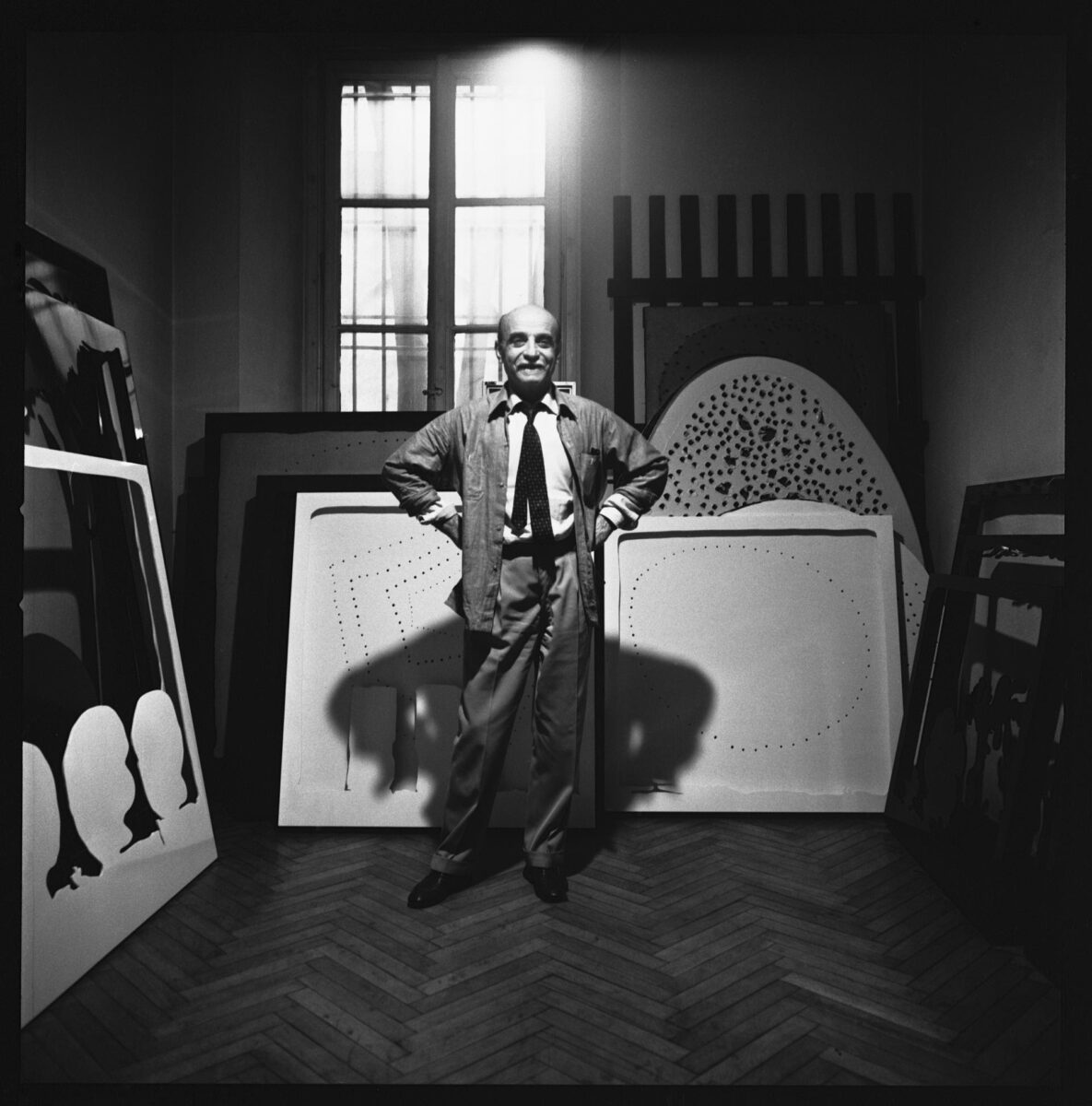
Immediately captivating and emanating intense energy in its vibrant yellow hue, Lucio Fontana’s Concetto spaziale, La fine di Dio represents the very best of his groundbreaking practice. Translating to “Spatial Concept, The End of God”, this group of paintings was born at a seismic moment in the 1960s, when significant advancements were happening in the exploration of space, which ultimately became the catalyst for the next decade of Fontana’s radical artistic production.
Collecting art has given us a new perspective on the world – one that is informed by looking beyond the established American canon and toward the greatest achievements in art making around the globe. Lucio Fontana is an artist who has always fascinated us. His groundbreaking approach to abstraction and the philosophical themes in his work have been foundational in evolving our thinking about the collection. The pursuit to find the perfect Fine di Dio painting took many years, and when we finally found it, it raised the bar for our collection to another level – an approach which has guided us in making further acquisitions over the course of our collecting journey.
Cindy & Howard Rachofsky
This May in New York, Sotheby’s will offer a seminal work from this era-defining series, painted in vivid cadmium yellow, from the collection of Cindy and Howard Rachofsky – passionate collectors, visionaries and, not least, philanthropists of the highest order, whose invaluable support has completely transformed the artistic landscape of their hometown Dallas and beyond. The densely pierced ovoid canvas will be presented as a highlight of Sotheby’s major Contemporary Evening Auction on May 15th with an estimate of $20-30 million – making this one of the most valuable works by Fontana ever to appear on the market.
Ahead of its auction, Concetto spaziale, La fine di Dio will go on view in Sotheby’s galleries in Milan from April 5th-11th and then again as part of the company’s preview exhibitions in New York from May 2nd-15th.
Of the 38 monumental paintings that make up this series, Concetto Spaziale, La fine di Dio is one of only four Fontana created in yellow – with the other three housed in esteemed private collections around the world. This particular version is, however, unarguably one of the most important and accomplished of the entire series, having been a highlight of the artist’s retrospective at the Metropolitan Museum of Art in 2019. The work is differentiated by the all-over density of its punctures, around which thickly built-up layers and globs of impasto coalesce, resulting in a composition that sears with visual drama and heightened intensity.
In addition to this, its appearance this season will mark the first time a yellow Concetto spaziale, La fine di Dio has come to auction since 2015, when another canvas of the same color, set the artist’s current auction record of $29.2 million. In fact, all six of Fontana’s top prices at auction are held by comparable masterworks from this series in a variety of bold monochromes. When Cindy and Howard Rachofsky acquired this particular painting in 2003, it set an auction record for the artist at the time.
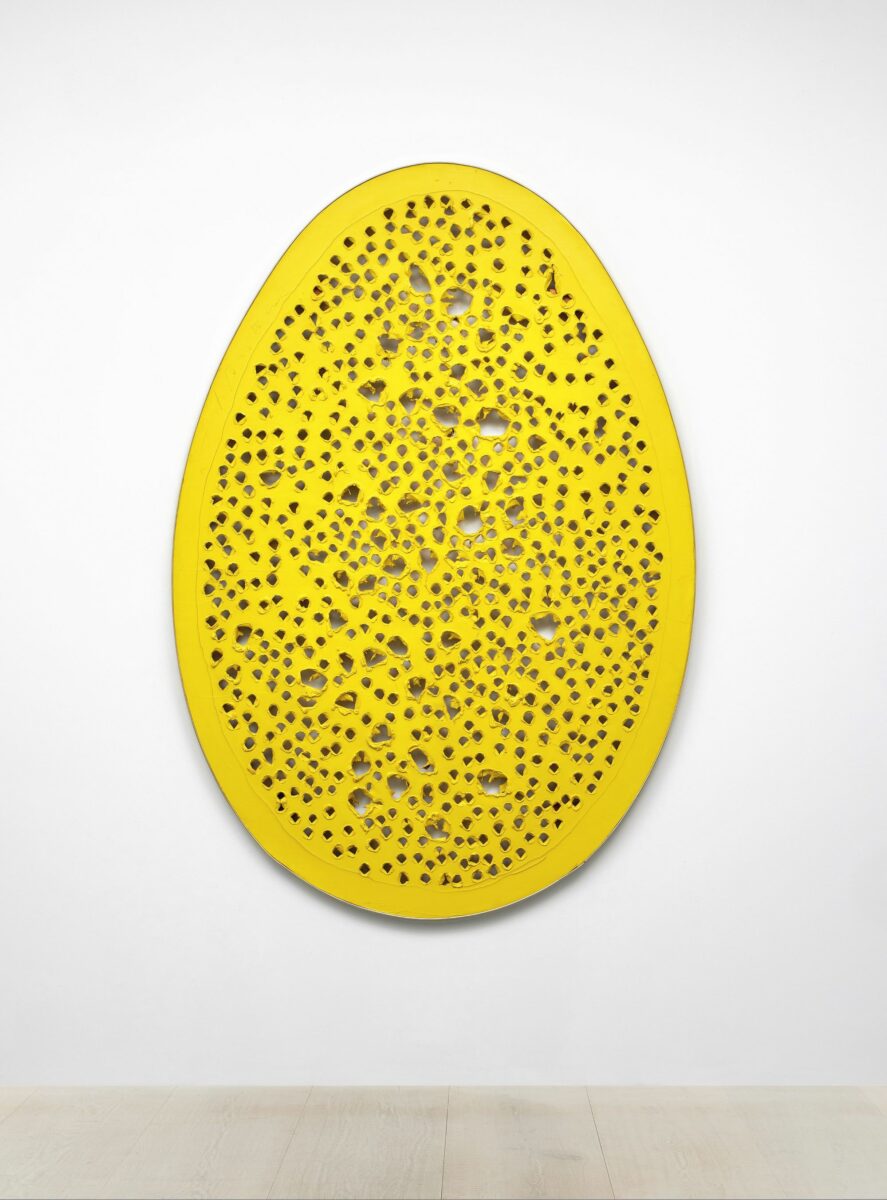
This is Lucio Fontana at his finest. Dazzling like the sun itself, the painting is the ultimate testament to the artist’s decades-long fascination with depth, light and space. Just as the impact of the Second World War and the atomic bomb broke open a new language for Jackson Pollock and Barnett Newman, the advent of space exploration, ushered in by Yuri Gagarin’s flight in 1961, became the catalyst for opening a new dimension of painting with Fontana’s La fine di Dio series. Created during the sixties, these lacerated oval-shaped canvases became a defining icon of a generation on the cusp of stellar technological advancement – the yellow palette perhaps even symbolizing the dawn of a bright new future for man. Some sixty years later, Fontana’s work still feels as radical as it did back then, with its ability to challenge our traditional understanding of the boundaries between painting and sculpture, and even space itself.
David Galperin Sotheby’s Head of Contemporary Art, Americas
Lucio Fontana created these works between 1963 and 1964 on the occasion of three seminal exhibitions in Zurich, Milan and Paris. The 1960s saw major scientific discoveries and developments around the world, most notably surrounding space travel, a subject which completely fascinated a 63- year-old Fontana. In fact, 1961 saw both the Russian cosmonaut Yuri Gagarin orbit the earth for the first time, and the US publicly proclaim their goal to land a man on the moon before the end of the decade (which they did, in 1969).
With outer space on his mind, Fontana sought to explore some of the broad notions raised by these discoveries in his art. For him, the irregular holes and punctures across the canvas – which create a sort of lunar surface – not only violated the picture plane, but also opened portals through which the viewer could access a new concept of space. At a moment when technological advances were tearing apart long-held visions of the universe, Fontana believed this new understanding of space and matter had given spirituality a new context, proclaiming:
Today it is certain, because man speaks of billions of years, of thousands and thousands of billions of years to reach, and so, here is the void, man is reduced to nothing…Man will become like God, he will become spirit.
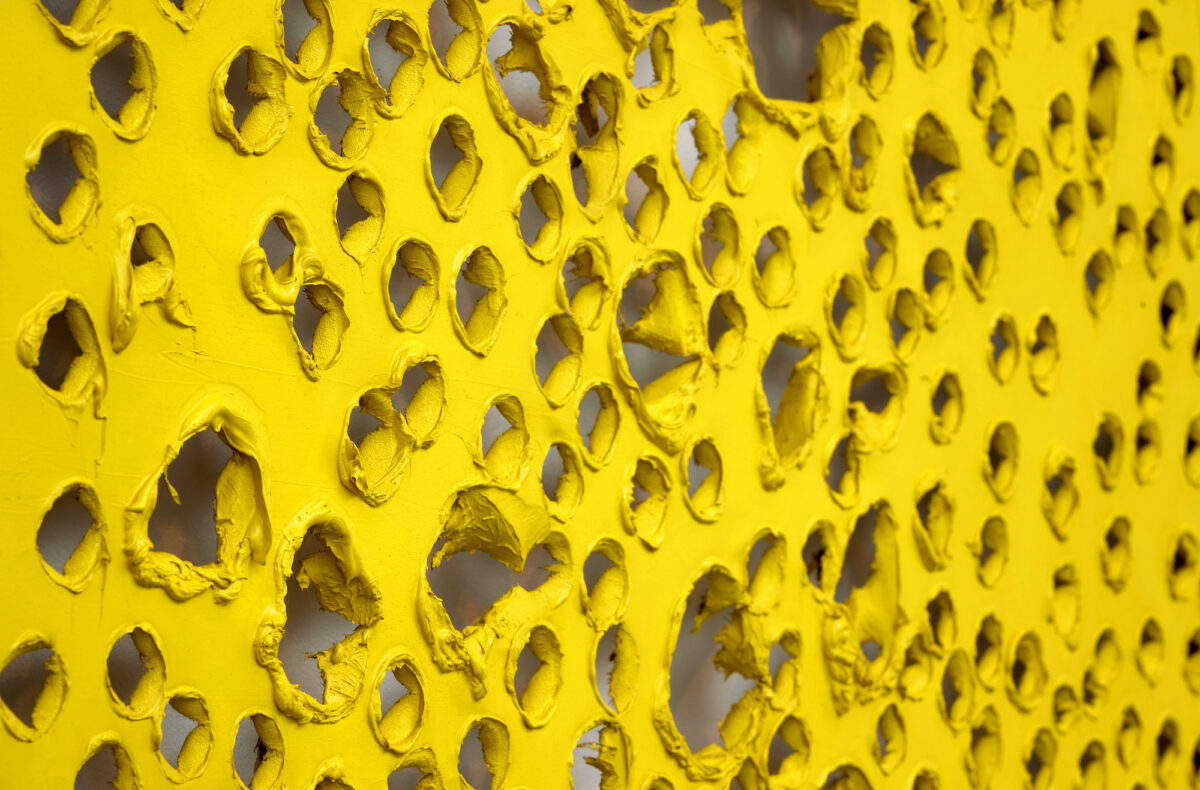
The decision to embed these punctures in an eggshaped form may well have been implicitly associated with the idea of regeneration, rebirth, and the cosmos.
Today, the Concetto spaziale, La fine di Dio paintings have also come to represent a defining embodiment not only of Fontana’s oeuvre, but also of the Spatialism movement at large, of which Fontana was both founder and figurehead. Spatialism enabled him to redefine the concept of painting, breaking the surface of the canvas to explore space as both a physical and psychological concept.
Fontana first ruptured the canvas in 1949 striking an otherwise uninterrupted monochromatic surface. Evolving first through the buchi, the tagli, and the olii, his strikes became ever more visceral and corporeal, rupturing not only the canvas itself, but the traditional boundary between painting and sculpture and, in turn, establishing a new dimension in artmaking. Befitting their importance, other works from the series are held in prestigious museum collections, including The Metropolitan Museum of Art, New York; Museo Nacional Centro de Arte Reina Sofía, Madrid; and Centre Pompidou, Paris

Lucio Fontana, Concetto spaziale, La fine di Dio will be a highlight of Sotheby’s major Contemporary Evening Auction on May 13th.
Ahead of its auction, Concetto spaziale, La fine di Dio will go on view in Sotheby’s galleries in Milan from April 5th-11th and then again as part of the company’s preview exhibitions in New York from May 2nd-13th.
Cindy and Howard Rachofsky acquired Lucio Fontana’s Concetto spaziale, La fine di Dio in 2003. In the years prior, it had become increasingly apparent to them that fully examining post-war European art – in particular, this important generation of Italian artists – would be central to the configuration and objectives of their collection. With Fontana being central to this history, sourcing a masterpiece by the artist, therefore, became something of a pursuit. Cindy and Howard’s core mission was to build a collection with a narrative different to that of other American collections at the time, both public and private. For the couple, this meant looking outside of the United States and toward the most significant international art movements, which hadn’t yet received widespread global recognition: from Arte Povera in Italy to the Gutai movement in Japan, to the Korean Dansaekhwa. Acquiring Fontana’s Concetto spaziale, La fine di Dio marked a seminal moment for Cindy and Howard Rachofsky. Looking
for an example of this caliber took years; its acquisition brought their collection to a higher level of ambition and raised the bar for future acquisitions.
In addition to this, in 1999, Cindy and Howard Rachofsky hosted the first edition of what was to become a legendary fundraising campaign for the Dallas Museum of Art and for amfAR, a foundation for AIDS research. Over the course of the last 25 years, annual iterations of the auction have together realized over $120 million.
But Cindy and Howard Rachofsky’s support of the Dallas Museum of Art does not stop there. In 2005, the Rachofskys made a promised testamentary pledge of their collection to the museum. One of the features of the agreement is that it allows for the content of the “gift” (that is, of the collection) to be honed and shaped during the Rachofskys’ lifetimes, ensuring they can continue their collecting journeys, acquiring – and also occasionally deaccessioning – works as they see fit, in close collaboration with the museum. To date, the Rachofskys have already donated over $50 million of art to the museum. This sale will enable them to continue making important acquisitions, further evolving the collection in ways which will continue to benefit the Dallas Museum of Art.

